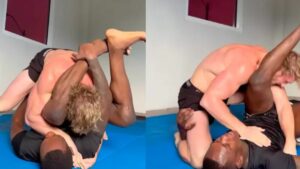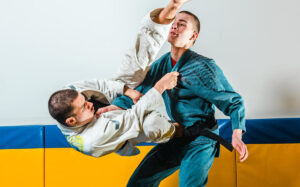In the world of grappling martial arts, Judo and Wrestling have been long-standing rivals, often sparking debates on which is superior. Both disciplines offer unique techniques, training methods, and benefits—ranging from self-defense to physical fitness.
So how do you know which one is right for you? In this blog post, we will explore the history, similarities, differences, and effectiveness of these two popular martial arts in various aspects so that you can make an informed decision on your grappling journey.
Key Takeaways
- Judo and Wrestling are both popular grappling martial arts that offer unique techniques, training methods, and benefits such as self-defense skills and improved physical fitness.
- Both arts share similarities in grappling techniques and focus on balance and body control but differ in rules, scoring systems, training methodologies with Judo emphasizing throws while Wrestling focuses on pins.
- Choosing between the two comes down to personal preferences based on individual goals, availability of training facilities nearby or schedules. Consider combining both for maximum versatility.
- Regardless of what you choose, consistency is key in drilling techniques properly for a successful learning curve.
Overview of Judo And Wrestling
If you’re looking to add a grappling martial art to your fitness routine or want to improve your self-defense skills, Judo and Wrestling are two great options. Both arts offer unique techniques and training methodologies that can benefit athletes of all levels. In this blog post, we’ll compare the similarities and differences between Judo and Wrestling, assess their effectiveness in self-defense and MMA, and provide factors to consider when choosing which one is right for you. Whether you’re an aspiring BJJ player or interested in traditional martial arts, this blog will help you make an informed decision about which grappling art should be part of your training regimen.
Brief History of Judo
Judo, which means “gentle way,” was developed in the late 19th century by Jigoro Kano, a Japanese educator and martial artist. As a young man, Kano found himself drawn to traditional Ju-Jitsu for self-defense purposes but later became disenchanted with its aggressive techniques.
Kano’s creation incorporated elements of both Ju-Jitsu and wrestling, focusing on throws, joint locks, and submission techniques rather than striking. By blending these methods with his own philosophy of mental and moral growth alongside physical training, he established the martial art known as Judo.
Through extensive travels across Europe and North America during the early 20th century, Kano promoted judo internationally by showcasing its effectiveness at various sports events.
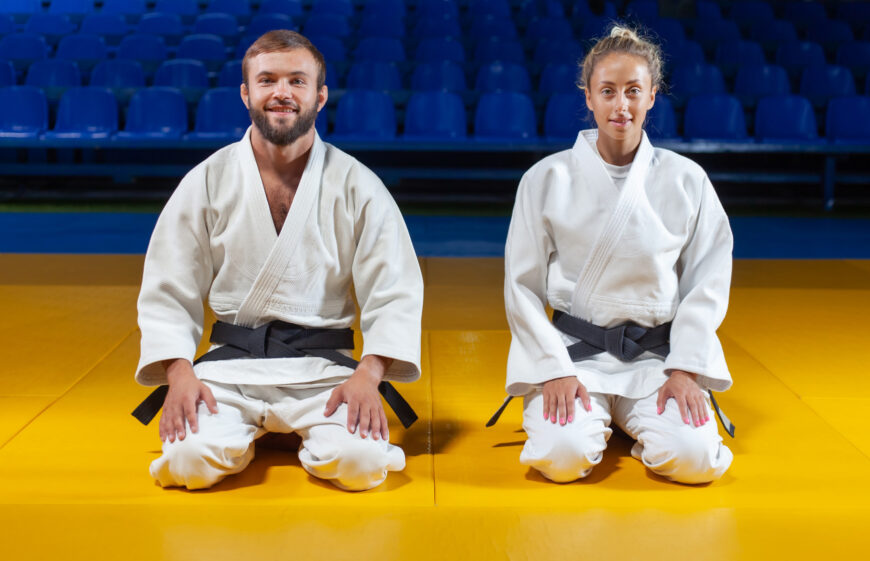
Brief History of Wrestling
Wrestling has deep historical roots, tracing back to ancient civilizations such as Egypt, Babylon, and Greece. Its first recorded appearance in European history can be found in cave drawings dating back approximately 15,000 years ago in France.
According to legend, Greco-Roman wrestling originated at the mythical wrestling match between Theseus of Athens and Kerkyon of Eleusis during the mythological era in ancient Greece.
This early form of wrestling involved intricate grappling techniques with throws and holds that honored physical strength and skillful execution.
The modern version of freestyle wrestling also emerged from Europe but became popularized among athletes worldwide when it was introduced into the Olympic Games program during the late 19th century alongside its Greco-Roman counterpart.
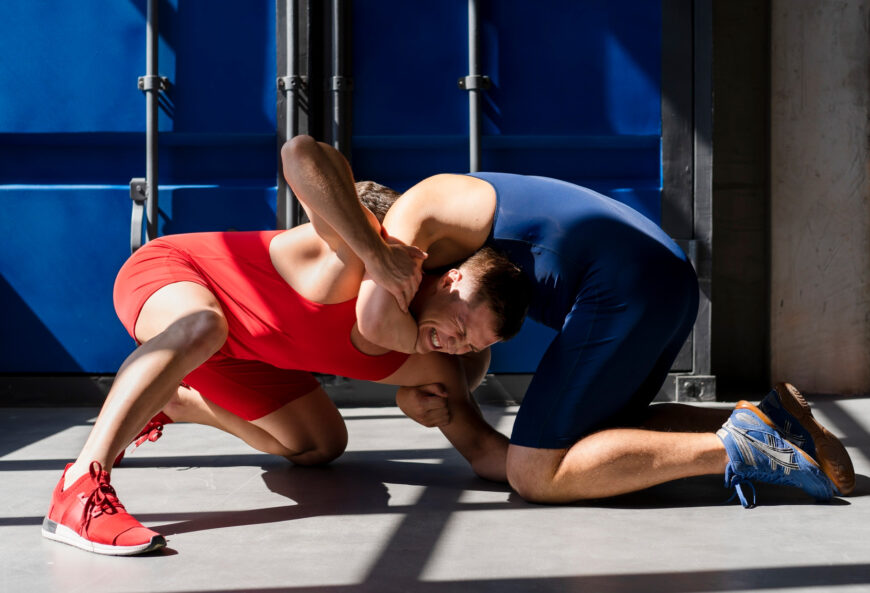
Similarities Between Judo and Wrestling
Both Judo and Wrestling share several similarities, including their focus on grappling techniques and body control.
Grappling Techniques
Grappling techniques are essential skills for those involved in martial arts, especially when focusing on Judo and Wrestling. These techniques can benefit running enthusiasts and fitness fanatics by improving their balance, strength, and agility. Some common grappling techniques include:
- Takedowns: Executed from a standing position to bring the opponent to the ground.
- Throws: Utilizing leverage and proper technique to lift and throw an opponent off-balance.
- Sweeps: Targeting the legs or base of an opponent to destabilize them, often leading to a takedown or improved position.
- Joint locks: Applying pressure on various joints of the body, forcing the opponent into submission or immobilization.
- Chokes: Restricting airflow or blood flow by applying pressure on the neck, often resulting in unconsciousness if not released.
- Pins: Holding an opponent down onto the mat while maintaining control of their movements.
- Holds: Controlling an opponent’s body with various grips and positions that limit their ability to escape or counterattack.
Incorporating these grappling techniques into your training regimen can contribute to overall physical fitness while also providing valuable self-defense skills for real-life situations.
Focus on Balance And Body Control
Both Judo and Wrestling prioritize balance and body control as key elements in their training methodology. These grappling arts require a high level of coordination to execute techniques effectively, making them excellent for improving overall physical fitness.
In Judo, practitioners focus on using leverage rather than strength to throw or takedown their opponents. This means that Judo players place a strong emphasis on maintaining proper posture and positioning during ground-based movements to ensure maximum efficiency when executing throws or submission holds.
Similarly, Wrestlers must maintain a steady base while attempting takedowns and controlling their opponents on the ground.
Differences Between Judo and Wrestling
Judo and wrestling have different rules and scoring systems, with Judo emphasizing throws, while wrestling focuses on pins. Training methodologies also differ, with Judo placing greater emphasis on technique over strength compared to Wrestling.
Rules And Scoring Systems
Judo and Wrestling each have their own unique set of rules and scoring systems that help to differentiate the two grappling arts. In this section, we will explore the main differences between Judo and Wrestling rules and how points are awarded in each sport.
| Judo | Wrestling |
|---|---|
| Judo has regulations regarding gripping and positioning. | Wrestling has fewer restrictions on grips and holds. |
| It is against the rules to grab a Judo player’s legs. | Leg grabs and attacks are allowed in wrestling. |
| Scoring in Judo is based on points. | Scoring in Wrestling is based on points and pinning the opponent. |
| Judokans must score 120 points and attain a minimum of 30 points from practical demonstrations in competitions. | Wrestling does not have a specific point requirement for competitions. |
| Judo techniques are based on the grip of the opponent’s suit. | Greco-Roman wrestling has takedowns aimed at the opponent’s knee areas. |
| Judo allows attacking the opponent’s legs and feet. | Greco-Roman wrestling does not allow leg and foot attacks. |
Understanding the rules and scoring systems of Judo and Wrestling can help you decide which grappling art is best suited for your personal preferences and long-term goals.
Training Methodologies
To become proficient in Judo or Wrestling, one must undergo training using specific methodologies. Here are some of the key differences between the two:
- Judo training typically involves a lot of repetition, drilling, and forms (kata). This helps to build muscle memory and improve technique.
- Wrestling training focuses more on live wrestling (sparring), with athletes practicing against each other to develop their skills.
- Judo emphasizes balance, leverage, and timing over brute strength. Training includes exercises specifically designed to improve these areas.
- Wrestling places more emphasis on strength and explosiveness, with athletes doing weightlifting and plyometric exercises to increase power.
- In Judo, there is a strong focus on throwing techniques (nage no kata) and grappling techniques (gokyo). Athletes train extensively in both areas.
- In Wrestling, takedowns are emphasized above all else, with great attention paid to learning different approaches such as low-risk/high-reward single-leg attacks or double-leg takedown methods generated from science-based research such as scientific shots training program by leading wrestlers like Ed Ruth.
- Both sports require discipline and perseverance; many practitioners attend multiple weekly classes to make improvements quickly in addition to solo workouts of calisthenics or running.
Overall, Judo tends to emphasize technique while wrestling focuses on raw power and intensity. However, both disciplines can be suitable for runners looking to expand their fitness routine while taking advantage of the health benefits associated with mixed martial arts training such as mental toughness building and self-improvement through physical challenges offered by sparring sessions in an encouraging gym culture that can help them meet their fitness goals faster than an individual workout practice alone could produce.

Throws
Throws are an essential aspect of both Judo and Wrestling, with the goal being to take down your opponent to the ground in a controlled manner. In Judo, throws, or Nage no kata, are classified into five groups known as Gokyo.
These include techniques such as Ippon seoi nage (one-arm shoulder throw) and Tomoe nage (circle throw). However, in Wrestling, throws tend to be more explosive power-based moves that require brute strength and speed.
When choosing between Judo and Wrestling for grappling training, it’s important to consider which style aligns with your goals. If you’re looking for a more holistic approach that focuses on balance and technique over brute strength, then Judo may be the way to go.
But if you’re interested in explosive power-based moves or plan on competing in wrestling tournaments, then wrestling would be a better option.
Pins
Pinning your opponent to the mat is essential in both Judo and Wrestling. In Judo, a pin involves holding an opponent on their back for 20 seconds or more, while in Wrestling, a pin is achieved by holding an opponent’s shoulders down on the mat.
Pinning requires immense strength and control, as well as precise timing and technique. Wrestlers are often trained extensively in pins from various positions such as near side cradle, far side cradle and three-quarter Nelsons to keep their opponents trapped on the ground.
Meanwhile, Judokans work on sutemi waza techniques like kesa gatame (scarf hold) which helps them trap their opponents with shoulder pressure over the face or neck.
Holds
In Judo and Wrestling, holds are an essential part of grappling techniques. Both martial arts utilize various types of holds to control their opponents on the ground or standing up.
In Judo, there are several types of holds called ‘osaekomi’ that aim to pin down the opponent for a certain amount of time to score points.
On the other hand, in Wrestling, holding your opponent down on their back for two seconds would result in a ‘pin,’ earning you points. Wrestlers use different kinds of pins such as Far Side Cradle, Near Side Cradle and Three-Quarter Nelson to immobilize an opponent’s shoulders onto the mat with all four scapulae touching at once.
Overall both sports hold great importance and technique when it comes to mastering each movement effectively during grappling sessions either Judo or wrestling style holds can assist in controlling your opponent efficiently depending on which sport is practiced more often by individuals interested in fitness training.
Attire And Equipment
When it comes to attire and equipment, both Judo and Wrestling require specific gear for training and competition. Below is a comparison table outlining the differences between the two grappling arts when it comes to attire and equipment.
| Judo | Wrestling | |
|---|---|---|
| Uniform | Judogi (Judo Gi) – A heavy, durable cotton jacket, pants, and a belt. | Singlet – A tight-fitting, one-piece garment made of spandex or Lycra. |
| Footwear | None – Judo is practiced barefoot on tatami mats. | Wrestling shoes – Lightweight shoes with good traction and ankle support. |
| Protective Gear | Optional: Mouthguard, knee pads, and ear guards. | Required: Headgear (ear guards) and optional knee pads and mouthguards. |
| Additional Equipment | None | Optional: Wrestling knee pads, mouthguards, and supportive gear (e.g., knee braces). |
While both Judo and Wrestling have distinct attire and equipment requirements, the choice between the two grappling arts will ultimately depend on individual preferences, availability of training facilities, and long-term goals in martial arts training.
Effectiveness In Self-Defense And MMA
In terms of self-defense, Judo’s focus on leverage and technique makes it more effective than wrestling, which relies heavily on explosive power. However, in MMA, wrestlers have a better track record due to their ability to control the fight with takedowns and top position.
Judo’s Strengths
Judo’s focus on throws and control make it an ideal choice for those seeking a well-rounded grappling skillset. Here are some of Judo’s strengths:
- Leverage and technique are more important than raw power and strength, making it accessible to anyone regardless of size or gender.
- Judo techniques involve explosive power, which can help in running and other sports that require quick bursts of energy.
- Judo emphasizes mat awareness, making it useful for athletes who compete in contact sports where they may be taken down.
- The throws used in Judo can help improve balance, coordination, and overall body control.
- Judo’s focus on standing techniques makes it effective as a self – defense martial art.
- Judo is a continuous self – building and improvement process that helps develop mental health.
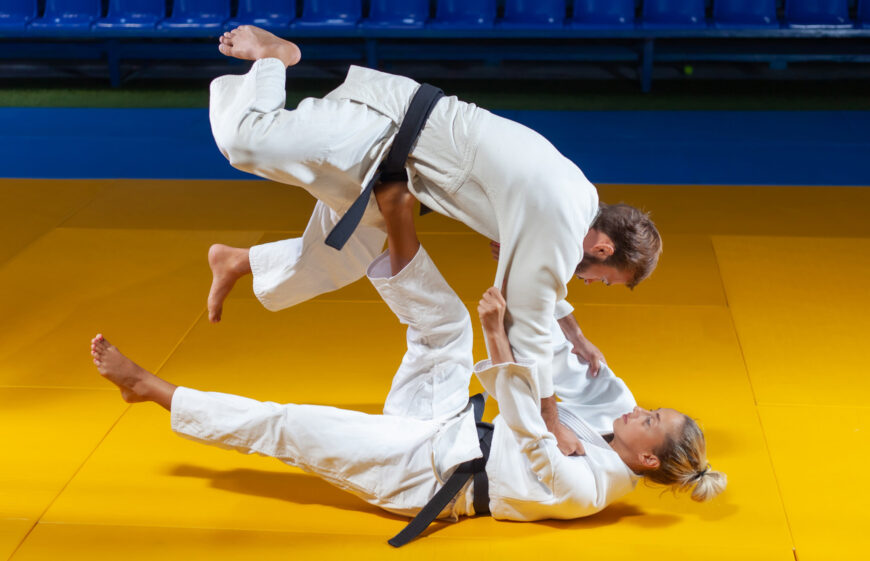
Wrestling’s Strengths
Wrestling is a grappling-based martial art that emphasizes takedowns, throws, and pins. Here are some of its strengths:
- Intense conditioning: Wrestling training is incredibly demanding and requires high levels of physical stamina, strength, and endurance.
- Explosive power: Wrestlers must be explosive in their movements to execute takedowns quickly and forcefully.
- Strong leg work: Wrestling places a strong emphasis on leg-based takedowns, making it beneficial for improving lower body strength.
- Upright stance: Unlike Judo which often involves crouching or ground-based movements, wrestling is more focused on an upright stance which improves posture and balance.
- Short learning curve: Wrestlers can learn basic techniques and start competing relatively quickly compared to other grappling-based martial arts.
- High reward-low risk takedowns: Many of the takedown techniques in wrestling have a low risk of injury while still providing high rewards in terms of points scored.
- Focus on control: Wrestling involves extensive drilling of techniques to ensure that the wrestler maintains control throughout the match.
- Effective ground fighting skills: Although not as emphasized as Judo or BJJ, wrestlers still possess strong ground fighting skills that can come in handy in self-defense situations or MMA fights.
Overall, wrestling is an effective combat sport that focuses on intense conditioning and explosive power while also emphasizing control over one’s opponent during matches.
Factors To Consider When Choosing Between Judo And Wrestling
Consider personal preferences, availability of training facilities, and long-term goals when deciding between Judo and Wrestling.
Personal Preferences
When choosing between Judo and Wrestling, personal preferences play a crucial role. Both martial arts require dedication, discipline, and hard work, but each has its unique characteristics that may appeal to different individuals.
For example, some people might prefer the intense throws and submissions of Judo while others might find comfort in the controlled takedowns and holds of Wrestling.
Additionally, availability of training facilities can influence the decision-making process as both sports may not be accessible in every location.
Availability Of Training Facilities
One of the factors to consider when deciding between Judo and Wrestling is the availability of training facilities. While both sports are Olympic-level disciplines with many great schools around the world, finding a nearby gym or club may vary depending on your location.
In most countries, including the United States, Judo is more popular than Greco-Roman wrestling, making it easier to find training facilities for Judo in those areas.
However, regardless of which sport you choose, there will always be places to train and learn from experienced coaches as both sports have a large following worldwide.
Another important consideration is gear costs; while required gear for Judo can be relatively affordable compared to Greco-Roman wrestling’s expensive singlets and shoes that could affect your overall training budget.
Long-term Goals
When choosing between Judo and Wrestling, it is important to consider your long-term goals in martial arts training. If you are interested in self-defense, both Judo and Wrestling can provide an effective skill set for defending yourself in a street fight or other real-life situations.
It is also important to consider your personal preferences and lifestyle when making this decision. For example, if you enjoy wearing traditional attire like a judogi or BJJ gi and practicing techniques with strict adherence to etiquette and tradition, then Judo may be more suitable for you.
On the other hand, if you prefer a more intense training approach that involves drilling techniques aggressively and with little regard for formality or etiquette, then wrestling may better suit your personality.
FAQs
What is the difference between Judo and Wrestling?
In short, Judo focuses on throws and submissions mainly performed from a standing position, while wrestling emphasizes takedowns, pins and holds in close combat.
Which grappling art is better for self-defense?
Both Judo and Wrestling can be effective for self defense but it ultimately depends on the situation. Judo’s emphasis on throws may be more useful in situations where an attacker grabs you, while wrestling techniques are more suited to grappling someone who is trying to take you down or control you.
Is one grappling art easier to learn than the other?
It really depends on individual experience and preferences. Some people find Judo easier because of its flowy movements whereas others might have an affinity towards wrestling since it involves more physical contact.
Can I practice both Judo and Wrestling at once?
Yes! Many martial artists train in multiple disciplines, including both Judo and Wrestling as they complement each other well when learning different submission techniques or styles of striking within standup fighting range.
Also Read: Wrestling vs Jiu-Jitsu: Who Will Reign Supreme in Combat Sports?
Conclusion
In conclusion, both Judo and Wrestling are formidable grappling arts that can provide a wealth of benefits for practitioners.
Ultimately, the choice between Judo or Wrestling comes down to personal preferences such as goals, availability of training facilities nearby you or your schedule amongst many other factors.
A BJJ practitioner looking to expand their game should consider combining Judo’s throws and submissions with Wrestling’s takedowns and pins for maximum versatility on the mat.
Regardless of what you choose at the end of the day: Both arts bring different approaches that are worthy considerations for anyone interested in grappling sports like BJJ or real-life situations requiring self-defense tactics.





